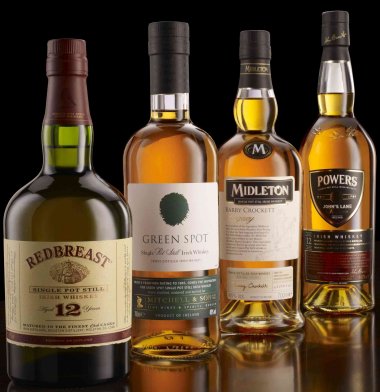Midleton Distillery is home to the whiskeys we will be tasting this Thursday at Nektar in New Hope.
The distillery in use today is not the one founded in 1825 by the three Murphy Brothers. They bought what was once a wool mill in County Cork from Lord Midleton and converted it into what we know as the Old Midleton Distillery. There, The Murphy brothers installed the world’s largest copper pot still with a capacity of 31,618 gallons. They produced a variety of whiskeys, including Cork Distillery Whiskey (now known as Paddy Whiskey) in the 19th century. Today, the old distillery has been converted into a tourist center. The new Midleton Distillery was constructed next to the old distillery in the early 70’s and is home to many of Ireland’s best whiskeys.
Irish whiskey was considered the best whiskey made in the world during the 19th century. Their triple distilled “pure pot still” style was defined by its smoothness, purity and oily mouth feel. The copper pot stills were much larger than their neighbors’ stills in Scotland. “Pure pot still” was once the only type of whiskey distilled in Ireland. It was generally a combination of malted and unmalted barley (the taxes on malted barley led many distilleries to use more than 50% unmalted barley in their mash), though sometimes oats and rye were sometimes added. Toward the end of the 19th century, a combination of a strong prohibitionist movement and the invention of the “Coffey still”(designed by Aeneus Coffey in the mid 1800’s) contributed to the decline in “pure pot still” Irish whiskey production by creating an easier and cheaper form of whiskey production. More grain spirits were now added to the “pure pot still” to create less expensive blends. Then in the early 20th century, the 1909 decision on “What defines whiskey?” in the U.K. was a blow to both Scottish and Irish whiskey producers by encouraging the production of these blends. Ultimately it was America’s Prohibition that brought the hammer down on Irish Whiskey production and very few distilleries were able to survive the loss of revenue.
The few remaining Irish distilleries banded together in the 1960’s to form the Irish Distillers Guild. IDG was made up of Jameson, Powers and the Cork Distillers at Old Midleton. They pooled their resources to build their new, modern distillery next to the Old Midleton distillery in County Cork. In 1972, Bushmills, the only other surviving Irish whiskey company, joined the group. In July of 1975, the new Midleton Distillery opened and the new facility was capable of producing all its different brands on site.
The real Irish whiskey production recovery began in earnest after the sale of IDG to the spirits group Pernod Ricard. The company began heavily advertising Jameson’s Irish whiskey to a thirsty American population and the brand took off. Jameson’s, alone, now makes up about 2/3 of all Irish whiskey produced on the market. In 2005, Bushmills was sold to Diageo and is second runner up. Thankfully, the renewed interest in Irish whiskey has brought back demand for the traditional “pure pot still” style- now called “single pot still”. Old brands like Redbreast 12, 15 and 21, as well as Green Spot and Yellow Spot, are winning awards again and showing up on bar shelves across the country. Thank goodness. Redbreast is one of my personal favorites and one of my preferences to pour for very good company.

